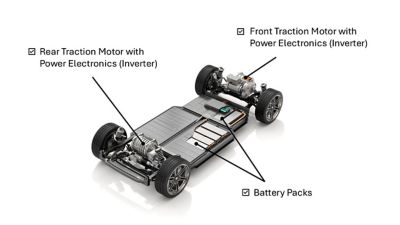-
United States -
United Kingdom -
India -
France -
Deutschland -
Italia -
日本 -
대한민국 -
中国 -
台灣
-
-
产品组合
查看所有产品Ansys致力于通过向学生提供免费的仿真工程软件来助力他们获得成功。
-
什么是电动汽车动力总成?
电动汽车(EV)是指依靠电力驱动的汽车,其动力通常由电池(BEV)或燃料电池(FCEV)提供。电动汽车动力总成是指电动汽车中将电能转换为机械运动的系统。
电动汽车动力总成包括:
- 储能系统——电池或燃料电池
- 电力电子设备——支持相关控制的逆变器/转换器
- 电气机械装置——能量转换系统(电机)
- 机械系统——传动系统
值得注意的是,电动汽车传动系统还包括传动轴及其机械部件。此外,电动汽车动力总成在运行过程中不会产生尾气排放,有助于提供更绿色环保的交通运输方案。
什么是动力总成?
动力总成是车辆内部的一组组件,可产生并控制动力,驱动车辆。
纯电动汽车(BEV)正在成为电动汽车的标准,因设计更简洁、维护成本更低,2023年占全球电动汽车总量的70%,2022年占轻型商用电动车销量的98%。
纯电动汽车动力总成由几部分构成:用于存储电能的电池组、用于转换电源以驱动电机的逆变器、将电能转换为机械运动的电动机(也称原动机),以及控制从电机到车轮的动力输出的齿轮箱。
与需要发动机、燃油喷射系统和排气系统的内燃机(ICE)相比,电动汽车动力总成是一种不同的架构,其不会产生尾气排放和内燃机噪声。此外,其活动部件更少,因此磨损更少,维护成本通常也更低,因为不再需要火花塞和机油更换等高维护项目。

电动汽车动力总成的重要组件
在全球努力实现更可持续的未来之际,电动汽车的优势已是众所周知。电池是电动汽车的关键组件,同时,还需要一系列电力电子组件和控制器来调配幕后的电流。
事实上,电力电子产品是电动汽车动力总成系统的重要组成部分,其有助于确保最佳能量转换,以及电动汽车的最佳运行、安全性和性能。
电动汽车动力总成的配电系统
配电系统主要控制电源的功率,其集成了电力电子组件,包括将电池的直流电转换为供电机使用的交流电的逆变器。此外,不同的电力电子控制拓扑还有助于提高性能,例如提供不同的逆变器开关策略来提高效率或实现最大扭矩。
DC-AC逆变器(牵引逆变器):DC-AC逆变器将电池的直流电转换为交流电,产生控制电机速度和加速度所需的交流电压。DC-AC逆变器包含有绝缘栅双极型晶体管(IGBT)或碳化硅金属氧化物半导体场效应晶体管(SiC MOSFET)功率器件,这些器件通过印刷电路板(PCB)或功率母排相连。这些电源半导体器件可作为高速开关,“开”“关”电机的大电流和高电压,以仿真正弦电流波形。
DC-DC转换器:DC-DC转换器可调节电池的高压DC输出,提供为照明、娱乐系统或空调等辅助系统供电所需的低压DC电源。其集成了不同电力电子器件,包括功率半导体、功率二极管、电容和磁性元件等。此外,也可将一款DC-DC转换器集成到包含充电器和接线盒的供电模块(PDM)中。
车辆控制单元:车辆控制单元是电动汽车的中央通信中心,收集并处理来自各种系统、传感器和控制器的数据,其可使车载充电器、电池、电机以及其它系统之间实现工作同步。
配电单元:配电单元可确保车内的每个系统都能获得适量的电能。其集成了开关、熔断器和继电器等电力电子器件,偶尔还包含半导体器件,这样,不仅可防止系统过载,而且还可实现高效工作。
固件和电子控制单元:通过由固件供电的电子控制单元(ECU)协调,可确保数据的高效交换和处理,从而使电动汽车动力总成组件实现高效安全的工作。
热管理系统:热管理系统可防止电池和电机免受极端温度的影响,确保整个电动汽车驱动系统和生态系统的高效安全流程。
电动汽车动力总成的机电能量转换
牵引电机:牵引电机是产生道路牵引力,驱动车辆前进的主要组件,其通常具有:
- 定子:这是电机的固定部分,由硅钢片(导磁钢片)和缠绕在定子周围周向间隔的槽中的铜线圈组成。
- 转子:这是电机的旋转部分,通常由硅钢片和永磁体组成,其经过精心布置,能够与定子设计实现最佳的相互作用,产生扭矩。还有其它不需要永磁体的电机拓扑,例如,使用“鼠笼”结构代替永磁体来产生扭矩的感应电机。
电流通过定子线圈时,会产生旋转磁场。该磁场会与转子的磁体(或感应电机的鼠笼)相互作用,使转子旋转起来并产生运动。电动汽车的加速器踏板,可通过控制系统和电力电子组件来控制从电池流向电机的电流和频率,从而控制电机产生的扭矩。
大多数电动汽车都配备了AC电机(要么是同步,如无刷永磁电机,要么是异步,如感应电机)。
变速箱和传动装置:在内燃机汽车中,通常需要一款机械传动装置来将发动机或电机的输出与车轮所需的输出相匹配。电动汽车变速箱通常比内燃机汽车的变速箱简单得多,因为电机不仅可在比内燃机更宽的速度范围内产生扭矩,而且还可在零速下产生扭矩。这就意味着,电动汽车不需要内燃机传动装置中常见的离合器和宽档位。然而,电机通常旨在以高于车轮所需速度的速度旋转,因此变速箱主要用于减速以及增大所提供的扭矩。
大多数电动汽车传动装置都有统一的固定齿轮传动比,无需任何组件来改变传动比。多速变速箱可能在高性能或更大的商用电动汽车中很实用,其可扩展所提供的扭矩和速度范围。
在混合动力电动车动力总成中,变速箱在使用常规或行星齿轮组将一个或多个电机与发动机的功率相结合时,发挥着至关重要的作用。变速箱将根据不同的驾驶条件,与电机和发动机协同工作,以最高效的方式提供动力,其中可能包括在内燃机不运行的情况下运行车辆,以及在驾驶条件适宜时,在发电模式下利用发动机和电机为电池充电。
差速器通常既可整合为电动汽车变速箱的一部分,也可根据动力总成的布局,作为单独的组件。
电气化动力总成的类型
电气化动力总成有三种主要类型,可提供不同的配置和功能,满足不同的需求和偏好。
纯电动汽车(BEV):电池电动汽车也称纯电动汽车,其所有动力都来自可充电电池包中存储的能量,不使用燃油箱等辅助能量储存装置。
纯电动汽车必须使用外部电源充电,当前,这类汽车的续航里程在100英里至400英里(约160至640公里)之间。在某些情况下,高端电动汽车的续航里程更高。现有的纯电动汽车车型,包括特斯拉Model 3、尼桑LEAF和宝马i3等,最近市场上也出现了许多其他新车型。
混合动力电动汽车(HEV):混合动力电动汽车将内燃机与电动传动系统相结合,与常规内燃机汽车相比,可实现更高的燃油经济性及性能。
混合动力电动汽车会在不同程度上由电力驱动,其具有各种优势性特性,例如:
- 再生制动,可将动能转化回电能,存储在电池中(还能与纯电动汽车共享)
- 启停系统,可在发动机空转时关闭发动机,以减少排放
- 发电机(由内燃机供电),既可为电池充电,也可为电机提供额外的动力
当前的混合动力电动车的续航里程在400到600英里(约640到960公里)之间。除插电式混合动力电动汽车外,混合动力电动汽车通常不使用外部电源充电。现有的混合动力汽车车型,包括福特Fusion混合动力车、丰田凯美瑞混合动力车和本田思域混合动力车等。
插电式混合动力电动汽车(PHEV):PHEV是HEV的子类,其可通过外部电源充电。目前,PHEV仅靠电力就可达到20英里到50英里(30到80公里)的续航里程,是短途城市旅行的理想选择。对于更远的旅程,插电式混合动力电动车可依赖汽油或柴油。现有的插电式混合动力电动车车型,包括丰田普锐斯Prime、雪佛兰Volt和本田Clarity等。
燃料电池电动汽车(FCEV)是第四种电动汽车,其工作原理是通过氢燃料电池(而非电池)产生电流。
内燃机汽车与电动汽车动力总成比较
一个多世纪以来,内燃机一直是汽车的主要动力来源。
虽然内燃机车的使用由来已久,但其仍面临着一些挑战,其中最重要的是化石燃料燃烧造成的环境污染。因此,各国政府和民众都在为电动汽车的普及而共同努力。
为了便于对比,以下列出了内燃机汽车和电动汽车动力总成的主要区别:
主要方面 | 内燃机汽车 | 电动汽车 |
动力总成 | 包括发动机、多速传动装置、燃油系统和排气系统 | 由电池、逆变器和控制器、电机以及传动装置组成 |
原动机 | 内燃机 | 电机 |
能源 | 化石燃料 | 电池、燃料电池 |
25~36% | 80~85% | |
环境影响 | 温室气体排放 | 实现了零排放或更低(对于HEV)的尾管排放,因此减少了对环境的影响 |
电动汽车动力总成的优势
电动汽车动力总成的优势,因个人驾驶习惯和偏好以及距离充电站基础设施的远近而异。。电动汽车动力总成的主要优势如下:
- 零排放:在减少污染和温室气体方面,BEV动力总成最显著的优势或许是:没有因化石燃料燃烧而产生的尾气排放;缩小了纯电动汽车整个生命周期的碳足迹。
- 减少了噪声污染:除没有温室气体排放之外,纯电动汽车动力总成产生的噪声也更低,有助于营造更安静的环境。
- 能效:纯电动汽车动力总成比内燃机动力总成更节能,可将80%以上的存储能量转化为运动。此外,再生制动等特性还可实现能量再循环。
- 维护成本更低:电动汽车动力总成的活动部件更少,因此其维护成本更低;只要在理想条件下进行适当的维护,电池使用寿命就可长达12年。不过与所有其它电池一样,汽车电池的容量会随着时间的推移下降。
- 燃料成本更低:为纯电动汽车供电的电力成本通常低于内燃机汽车的汽油或柴油成本。密歇根大学的一项研究显示,在美国,汽油动力汽车的燃料成本是电动汽车电力成本的两倍以上。
- 总体拥有成本(TCO)更低:虽然纯电动汽车通常会有更高的前期购买成本,但燃料和维护的成本减少有助于降低总体拥有成本,从而降低在整个车辆使用寿命内的运行成本。
电动汽车动力总成的不足
电动汽车动力总成也有不足之处,包括:
- 成本:由于动力总成组件(主要是电池)的成本较高,因此目前电动汽车所需的前期投入比内燃机汽车高。
- 充电时间:电池充电所需时间通常在30分钟到几个小时之间,具体取决于充电站的充电容量,相比之下,将内燃机汽车油箱加满油只需几分钟时间。
- 消费者行驶里程焦虑:目前,纯电动汽车单次充电的续航里程有限。由于充电站没有加油站那么普及,而且电池充电时间较长,因此消费者会对驾驶纯电动汽车长途旅行感到焦虑。
电动汽车动力总成设计
电动汽车动力总成设计的主要目标是实现高效的热管理并增加续航里程,其侧重于提高功率密度(单位体积所提供的电能),助力在发电和热耗散之间实现微妙的平衡。电动汽车的里程、效率和整体性能可以在组件、系统和架构层面进行优化。
例如,将驾驶模式整合到驱动系统架构中,可显著提高汽车性能,从而可根据驾驶条件实现多种配置。
集成到硬件架构中的电子控制单元可提供增强功能,例如,将驾驶员的油门指令转换为电机和电池的指令,以满足诸如0~60英里/小时加速度和最佳能耗等特定要求。这些电子控制单元由动态编程或能耗最小化策略等算法提供支持。
电动汽车动力总成的未来
在推动电气化的过程中,电动汽车动力总成是一项令人振奋的创新,其在效率、环保和性能方面带来了更大的优势。随着越来越多的消费者转而购买电动汽车,市场上将出现更多样化的车型,从SUV、豪华车到卡车等,不一而足。
Ansys站在这场技术革命的最前沿,为清洁技术解决方案的发展提供强大支持,而这些解决方案正在以最佳方式改变世界的能源利用方式。
Ansys ConceptEV® 软件是一款设计仿真平台,其可提高整个电动汽车动力总成的性能。该平台可帮助跨职能工程团队连接组件模型并评估车辆级需求,不仅可在整个开发流程中实现快速准确的决策,而且还可整合:
- 多保真度组件模型
- 嵌入式控制算法
- 与组件设计工具集成
- 动力总成功能仿真
- 系统权衡量化
如果您希望帮助贵公司工程师实现更节能的动力总成、达到目标成本要求,请免费试用Ansys ConceptEV软件。或者您也可以观看演示,了解ConceptEV软件如何帮助您提高电动汽车动力总成的效率和性能。
相关资源
现在就开始行动吧!
如果您面临工程方面的挑战,我们的团队将随时为您提供帮助。我们拥有丰富的经验并秉持创新承诺,期待与您联系。让我们携手合作,将您的工程挑战转化为价值增长和成功的机遇。欢迎立即联系我们进行交流。










